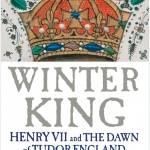King Henry VII of England was a problematic king. He is so difficult to encapsulate that, as Thomas Penn points out in the introduction to his excellent book Shakespeare, whose history plays set out the foundational myths of the Tudor-Stuart dynasty, did not even write about him. As Penn puts it, this is not because material is lacking but “because the reign was simply too uncomfortable to deal with.” For Shakespeare, perhaps, but not for Penn, who has used archival materials, most notably account books, to piece together a fascinating portrait of the king and his reign.
Born in 1457, Henry of Richmond (the future Henry VII) was a grandson of Catherine of France and her second husband Owen Tudor (Catherine’s first husband was Henry V). Henry’s mother, Margaret Beaufort, was a great-great-granddaughter of Edward III, but through John of Gaunt’s morganatic marriage to Katherine Swinford. (If you haven’t read Anya Seton’s wonderful historical novel Katherine about that liaison I highly recommend it.) So Henry was not in direct line to the throne by any means, and in fact spent much of his youth in France. But it was Henry of Richmond who led the armies that defeated Richard III at Bosworth and was crowned king thereafter.
That’s one reason Shakespeare didn’t write about him: it wasn’t clear that Henry VII was the rightful king, though he consolidated his family’s hold on the throne through a nearly 25 year reign. (It was perhaps Shakespeare who turned Richard III into a villain with his play; such is the claim of Josephine Tey in her smashing detective story The Daughter of Time.) Another reason was the way Henry amassed power. As Penn describes in vivid and interesting detail, Henry used informants to roust out possible disloyalty. His agents then forced them to sign bonds. These bonds didn’t so much buy loyalty as ensure it. As a result, his subjects had before them many examples of nobles and merchants forced to give up goods, warehouses, or even their own houses, as forfeiture to the king. (Henry was not above taking a house he liked from his own mother.)
Henry was an astute businessman, and muscled his way into the cloth trade. More important, he funded, and profited greatly from, the import of alum from the Levant. It was a sidelight, but in doing so he disobeyed the Pope’s orders – the Papacy derived much of its income from its monopoly control of Europe’s alum mines. (Alum is required for setting dyes. In an economy based on textiles, it was a vital resource. For a good description of the contemporary cloth trade, including the alum trade, yes, there’s another novel: Dorothy Dunnett’s Niccolo Rising, the first of her House of Niccolo series.) The disobedience had major implications several decades later, when his son Henry VIII could not obtain a Rome-sanctioned annulment of his marriage.
Henry also had dynastic designs, hoping at various times to marry off his children to the heirs of the Spanish, Habsburg, and French thrones. It was his oldest son, Arthur, who was married first to Catherine of Aragon; his daughter Mary was variously betrothed. Prince Henry seems to have been held in reserve on the marriage front; he married Catherine two months after his coronation. That coronation is the sign of the success of Henry VII’s approach: the crown did pass dynastically; the Wars of the Roses really had come to an end. To his credit, it was Henry VII who wrought that change.
Towards the end of Henry’s life, three men, all named Thomas – Wolsey, More, and Cromwell – had appeared at court. Henry VIII’s accession meant that the worst excesses of his father’s rule were reversed. But in Henry VII’s approach to ruling, Penn suggests, there are the seeds of so much else: the insistence that the King ruled the Church; the English Reformation; the search for a dynasty that led to the union of England and Scotland.
Have a book you want me to know about? Email me at asbowie@gmail.com. I also blog about metrics at asbowie.blogspot.com.



